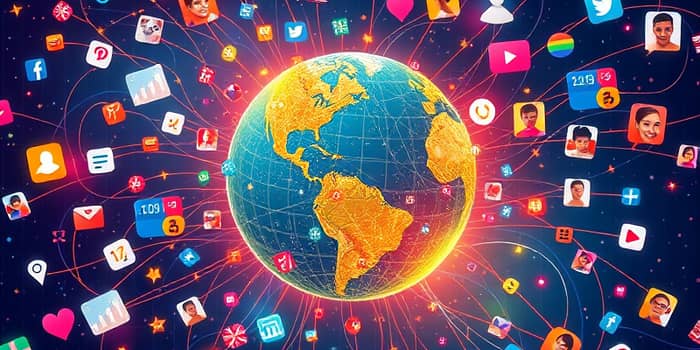
In mid-2025, social media has become a central force in shaping how consumers and investors perceive brands, products, and financial markets. From billions of daily interactions to AI-driven sentiment models, the digital landscape now dictates narrative power and market behavior at unprecedented speed.
By examining global reach, demographic trends, influence mechanisms, and predictive analytics, we can uncover how social networks sway market sentiment and why it matters for businesses, regulators, and individual investors alike.
Social media’s footprint is staggering: 63.9% of humanity—over five billion people—engage online, with 4.7% year-over-year growth adding roughly 72 million new users. Collectively, they dedicate an average of 2 hours and 21 minutes per day to platforms, totaling more than 14 billion hours of global usage daily.
These figures underscore the unmatched global reach of social networks and highlight why businesses invest heavily in social listening, engagement strategies, and community building to capture attention in an ever-crowded digital space.
Generational preferences and cultural differences determine where conversations take place:
With TikTok’s 1.59 billion global monthly users (including 135 million in the U.S.), short-form video is revolutionizing discovery and engagement. Platforms adapt to these shifts, introducing new features like Instagram Reels, Twitter Spaces, and Threads to capture evolving user attention.
Influencer marketing, peer effects, and user-generated content (UGC) have disrupted traditional advertising. Influencers—both human and AI-driven “virtual influencers”—fuel a creator economy projected to reach $37.8 billion by 2030.
Companies that master prompt strategies to encourage organic consumer advocacy and sharing can spark movements, turning passive audiences into enthusiastic brand ambassadors.
Social platforms now function as critical purchase touchpoints: 82% of consumers use them for product research, and nearly half of all buying decisions are influenced by creators. In the U.S., social commerce is a $104 billion market, on track to exceed $150 billion by 2029.
Short-form videos and live streams have become powerful conversion drivers, with 48% of Gen Z preferring to discover products via TikTok and Instagram Reels. Shoppable posts, integrated checkout experiences, and AI-powered recommendations blur the line between browsing and buying, creating frictionless pathways from inspiration to purchase.
Social listening tools are indispensable for gauging consumer mood and calculating marketing ROI. Teams leveraging these technologies report up to double the confidence in their metrics compared to those relying solely on traditional surveys and web analytics.
Platform algorithms—governed by engagement signals like likes, shares, comments, and recency—dictate which content rises to prominence. On Reddit, upvotes and downvotes steer visibility; on Pinterest, pin quality and relevance shape discovery. Understanding these ranking factors is crucial for amplifying brand narratives and monitoring sentiment shifts in real time.
Moreover, tweet-based sentiment analysis now serves as an early warning system for market fluctuations. Studies show that spikes in negative or positive social media sentiment can precede sudden sell-offs or rallies in both developed and emerging markets, offering a strategic advantage to investors armed with real-time sentiment dashboards.
With great influence comes great responsibility. Regulators and policymakers increasingly deploy AI-driven monitoring to detect manipulation, misinformation campaigns, and coordinated inauthentic behavior that can distort stock prices and consumer perceptions.
Staying ahead of these regulatory shifts requires robust compliance frameworks and continuous risk assessment, ensuring brands maintain trust and avoid potential legal pitfalls.
AI is revolutionizing content creation and sentiment analysis. Ninety percent of businesses using generative AI report significant efficiency gains, and 73% see enhanced engagement using AI-powered creative strategies.
Advanced natural language processing and machine learning models now parse millions of social posts to detect emerging trends, flag sentiment anomalies, and forecast consumer behavior at scale. These AI-driven sentiment models and predictive tools empower marketers and investors with actionable insights, enabling agile decision-making in a fast-moving digital ecosystem.
In 2025, ROI on social media marketing depends on nuanced audience targeting, engaging content formats, and community building. Marketers rank Facebook and Instagram as top platforms for returns (29%), followed closely by YouTube (26%) and TikTok on the rise.
Successful campaigns prioritize two-way communication and community engagement over one-sided promotion. Live Q&As, interactive polls, and user challenges foster deeper relationships, driving higher brand loyalty and improved conversion rates compared to static ads.
From meme stock surges to viral social commerce launches, the digital sphere continues to evolve:
The 2021 GameStop frenzy illustrated how Reddit communities can coordinate trading activities, while more recent creator-led product drops on TikTok have generated millions in revenue within hours.
Virtual influencers—computer-generated personalities with human-like followings—are now collaborating with global brands, demonstrating the potential for entirely new forms of digital endorsement and engagement.
As we move forward, staying attuned to platform innovations, algorithm updates, and evolving user behaviors will be essential. By combining data-driven insights, strategic AI tools, and authentic storytelling, organizations can harness social media’s immense power to shape market sentiment and drive sustainable growth.
In a world defined by interconnected digital conversations, understanding and influencing sentiment is both an art and a science. Embracing this dynamic landscape will determine which brands and investors thrive in the attention economy of the future.
References













